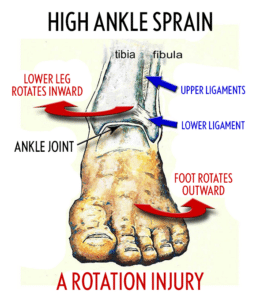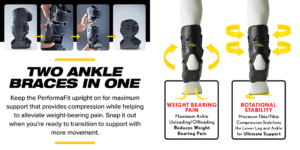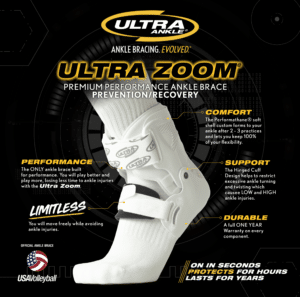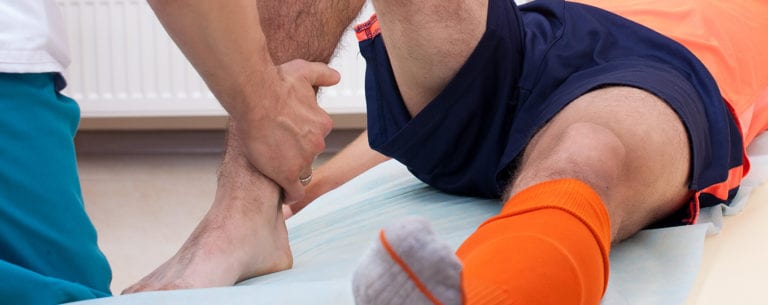High ankle sprains, also known as syndesmotic ankle sprains, are distinct from the more common low ankle sprains. They involve injury to the ligaments that connect the tibia and fibula, particularly the anterior inferior tibiofibular ligament, posterior inferior tibiofibular ligament, and the interosseous membrane. These injuries are often caused by an external rotation and/or dorsiflexion trauma, common in high-impact sports like football, soccer, and basketball. (1) (2)

Symptoms and Diagnosis
The symptoms of a high ankle sprain can be subtle compared to a regular ankle sprain. They typically include pain radiating up the leg, especially when bearing weight or pivoting on the foot, and some swelling. However, high ankle sprains do not usually cause significant bruising or swelling, which can make them difficult to diagnose without proper medical assessment. (1) (2)
To diagnose a high ankle sprain, a physician will perform a physical exam that may include the syndesmosis squeeze test, where the tibia and fibula are compressed together to elicit pain. Imaging tests like X-rays, MRI, or CT scans may also be necessary to rule out fractures or other injuries. (3)
Treatment Options
The treatment of high ankle sprains generally follows the RICE protocol: Rest, Ice, Compression, and Elevation. Rest involves avoiding weight-bearing activities to allow the ligaments to heal. Ice should be applied for 15-20 minutes several times a day to reduce swelling. Compression with an elastic bandage helps control swelling, and elevating the leg above the heart reduces pain and inflammation. (1) (3)
In addition to these initial treatments, physical therapy plays a crucial role in recovery, focusing on regaining strength, range of motion, and proprioceptive training. In severe cases, surgery may be necessary to repair torn ligaments and restore stability to the ankle. (2)
The Role of Ultra Ankle® Braces
Ultra CTS® and Ultra Zoom® ankle braces can significantly aid in the treatment, recovery, and further prevention of high ankle sprains. These braces provide the necessary support and stabilization to the ankle and lower leg, reducing the risk of further injury and allowing for pain free weight-bearing activities as the healing progresses. Here are the specific features of each brace:
Ultra CTS® Ankle Brace:
Dynamic Hinged-Cuff Technology: Specifically designed to help prevent external ankle rotation which causes syndesmotic (High) ankle sprains. The Ultra CTS aids in healing by supporting soft tissue recovery. Will help to alleviate weight-bearing pain, encouraging early activity and aiding in quicker rehabilitation post-injury.
Flexible Soft Shell: Made from Performathane®, the Ultra CTS forms a custom-fit to your ankle, providing a comfortable, snug, and secure fit.
PerformaFit® Technology: Transition from the Ultra CTS acute injury ankle brace to a low-profile Ultra CTS activity ankle brace by detaching the PerformaFit upper cuff section. Reattach the PerformaFit cuff section anytime additional ankle support is needed.
The Ultra CTS® is best when used after a walking boot or immediately after injury to help reduce weight bearing pain and provide maximum ankle support and stabilization to aid the healing process and prevent further ankle injury.

Ultra Zoom® Ankle Brace:
Hinged-Cuff Design: Allows for natural up and down ankle movement (dorsiflexion & plantarflexion) while offering excellent support to not only help prevent low “turning” ankle injuries, but also to help prevent rotation “twisting” of the lower leg which can lead to high ankle injuries.
Flexible Soft Shell: Made from Performathane®, the Ultra Zoom forms a custom-fit to your ankle, providing a comfortable, snug, and secure fit.
Durability: Exceptional durability to last multiple seasons. A full ONE YEAR warranty on every component.
The Ultra Zoom® is best when used after the high ankle injury is mostly healed and the athlete is released to return to partial or full activity.

These features make the Ultra Zoom and Ultra CTS ankle braces highly effective in aiding recovery from high ankle sprains, ensuring that patients can return to their daily activities or sports with confidence. (1) (2)
Conclusion
High ankle sprains are complex injuries that require careful diagnosis and treatment. By following proper medical guidance and utilizing supportive devices like the Ultra Zoom and Ultra CTS ankle braces, individuals can effectively manage their recovery and reduce the risk of future injuries. If you have further questions about either the Ultra CTS or Ultra Zoom ankle braces, or, would like to communicate with one of our Certified Athletic Trainers, please reach out to us here.
